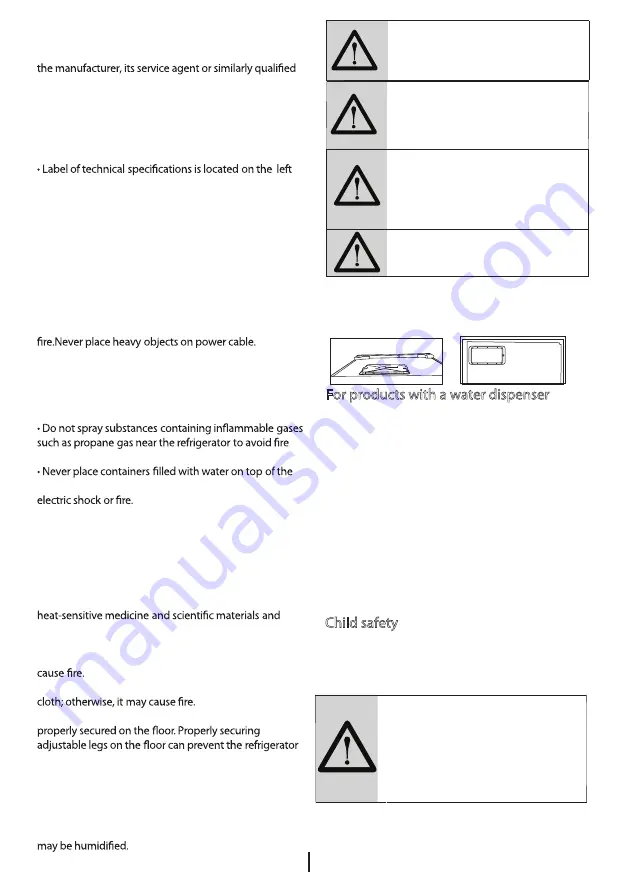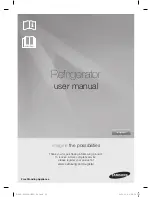
For products with a water dispenser
• Pressure for cold water inlet shall be maximum 90 psi
(6.2 bar). If your water pressure exceeds 80 psi (5.5 bar),
use a pressure limiting valve in your mains system. If
you do not know how to check your water pressure ask
for the help of a professional plumber.
• If there is risk of water hammer effect in your
installation, always use a water hammer prevention
equipment in your installation.Consult Professional
plumbers is you are not sure that there is no water
hammer effect in your installation.
• Do not install on the hot water inlet. Take precautions
against of the risk of freezing of the hoses. Water
temperature operating interval shall be 33°F (0.6°C)
minimum and 100°F (38°C) maximum.
• Use only potable water.
• Exposing the product to rain, snow, sun and wind is
dangerous with respect to electrical safety.
• If the SUPPLY CORD is damaged, it must be replaced by
person in order to avoid a hazard.
• Never plug the refrigerator into the wall outlet during
installation.Otherwise, risk of death or serious injury
may arise.
• This refrigerator is intended for only storing food items.
It must not be used for any other purpose.
wall inside the refrigerator.
• Never connect your refrigerator to electricity saving
systems; they may damage the refrigerator.
• If there is a blue light on the refrigerator, do not look at
the blue light with optical tools.
• For manually controlled refrigerators, wait for at least
5 minutes to start the refrigerator afterpower failure.
• This operation manual should be handed in to the new
owner of the product when it is given to others.
• Avoid causing damage on power cable when
transporting the refrigerator. Bending cable may cause
• Do not touch the plug with wet hands when plugging
the product.
• Do not plug the refrigerator if the wall outlet is loose.
• Water should not be sprayed on inner or outer parts of
the product for safety purposes.
and explosion risk.
refrigerator; in the event of spillages, this may cause
• Do not overload the refrigerator with food. If overloaded,
the food items may fall down and hurt you and damage
refrigerator when you open the door.
• Never place objects on top of the refrigerator;otherwise,
these objects may fall down when you open or close the
refrigerator’s door.
• As they require a precise temperature, vaccines,
etc. should not be kept in the refrigerator.
• If not to be used for a long time, refrigerator should
be unplugged.A possible problem in power cable may
• The plug’s tip should be cleaned regularly with a dry
• Refrigerator may move if adjustable legs are not
to move.
• When carrying the refrigerator, do not hold it from
door handle. Otherwise, it may be snapped.
• When you have to place your product next to another
refrigerator or freezer, the distance between devices
should be at least 8 cm.Otherwise, adjacent side walls
WARNING:
Keep ventilation
openings, in the appliance enclosure
or in the built-in structure, clear of
obstruction.
WARNING:
Do not use mechanical
devices or other means to accelerate
the defrosting process, other than those
recommended by the manufacturer.
EN
3
WARNING:
Do not use electrical
appliances inside the food storage
compartments of the appliance,
unlessthey are of the type recommen
ded by the manufacturer.
WARNING:
Do not damage the
refrigerant circuit.
The product shall never be used while the compartment
which is located at the top or back of your product and .
in which electronic boards are available (electronic board
box cover) (1) is open.
1
1
Child safety
• If the door has a lock, the key should be kept away from
reach of children.
• Children should be supervised to ensure that they do
not play with the appliance.
DANGER:
Risk of child entrapment.
Before you throw away your old
refrigerator or freezer:
• Take off the doors.
• Leave the shelves in place
so that children may not easily climb
inside.
Summary of Contents for BFBF2414 Series
Page 48: ......





































